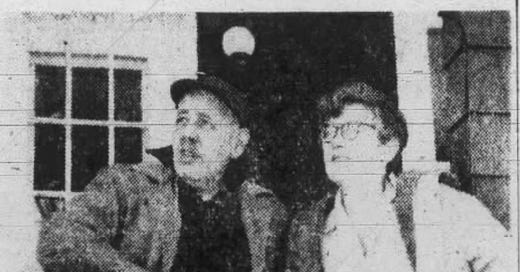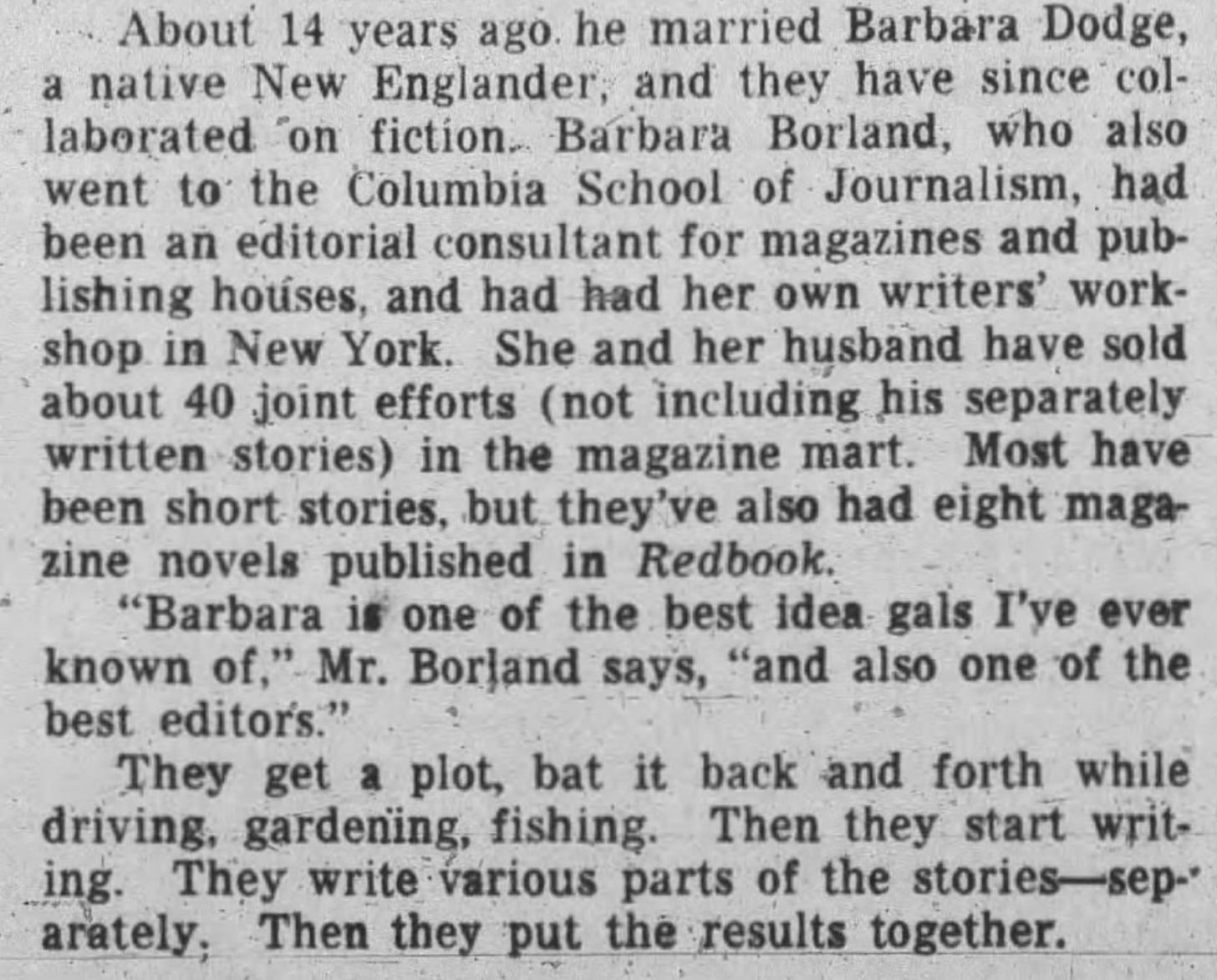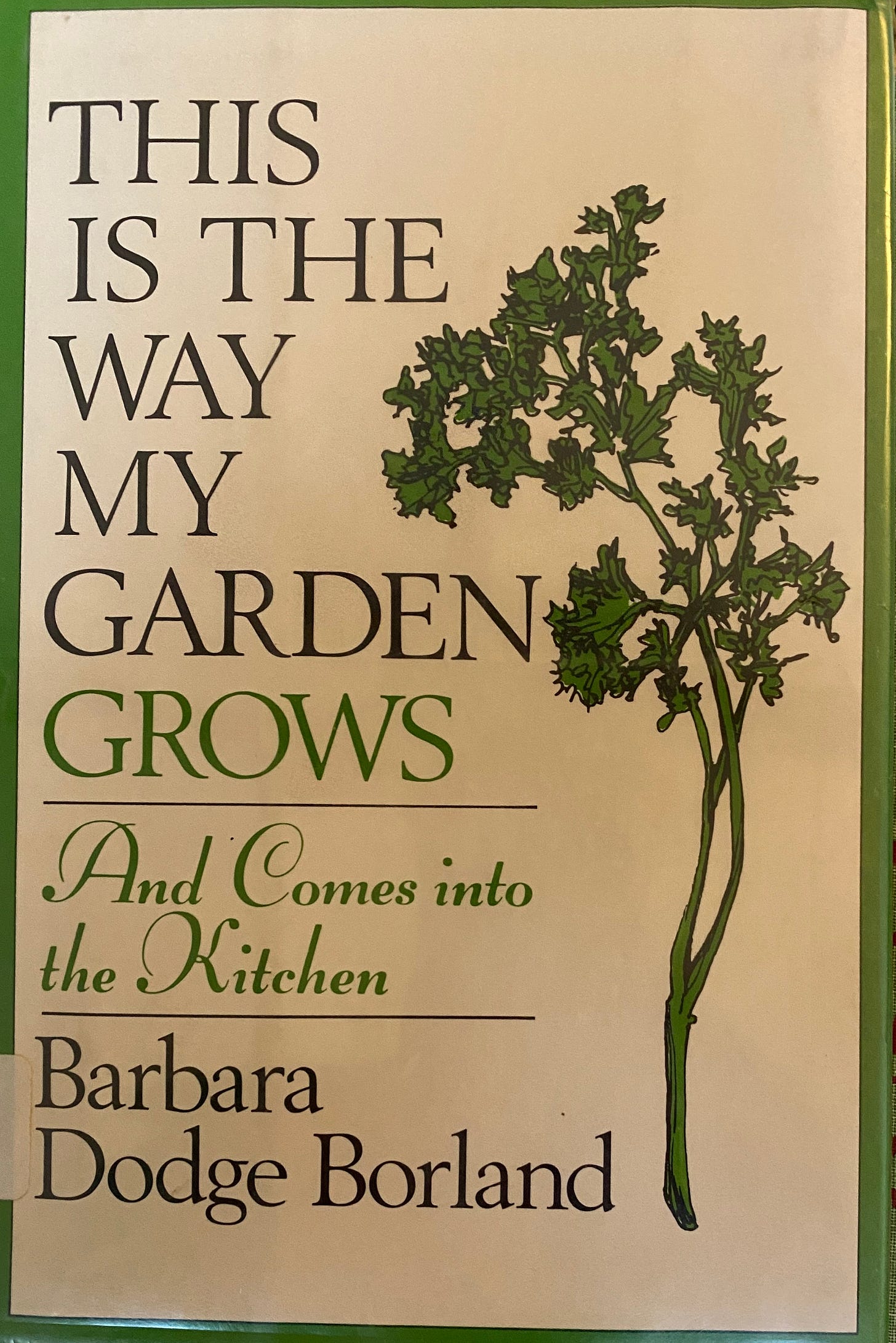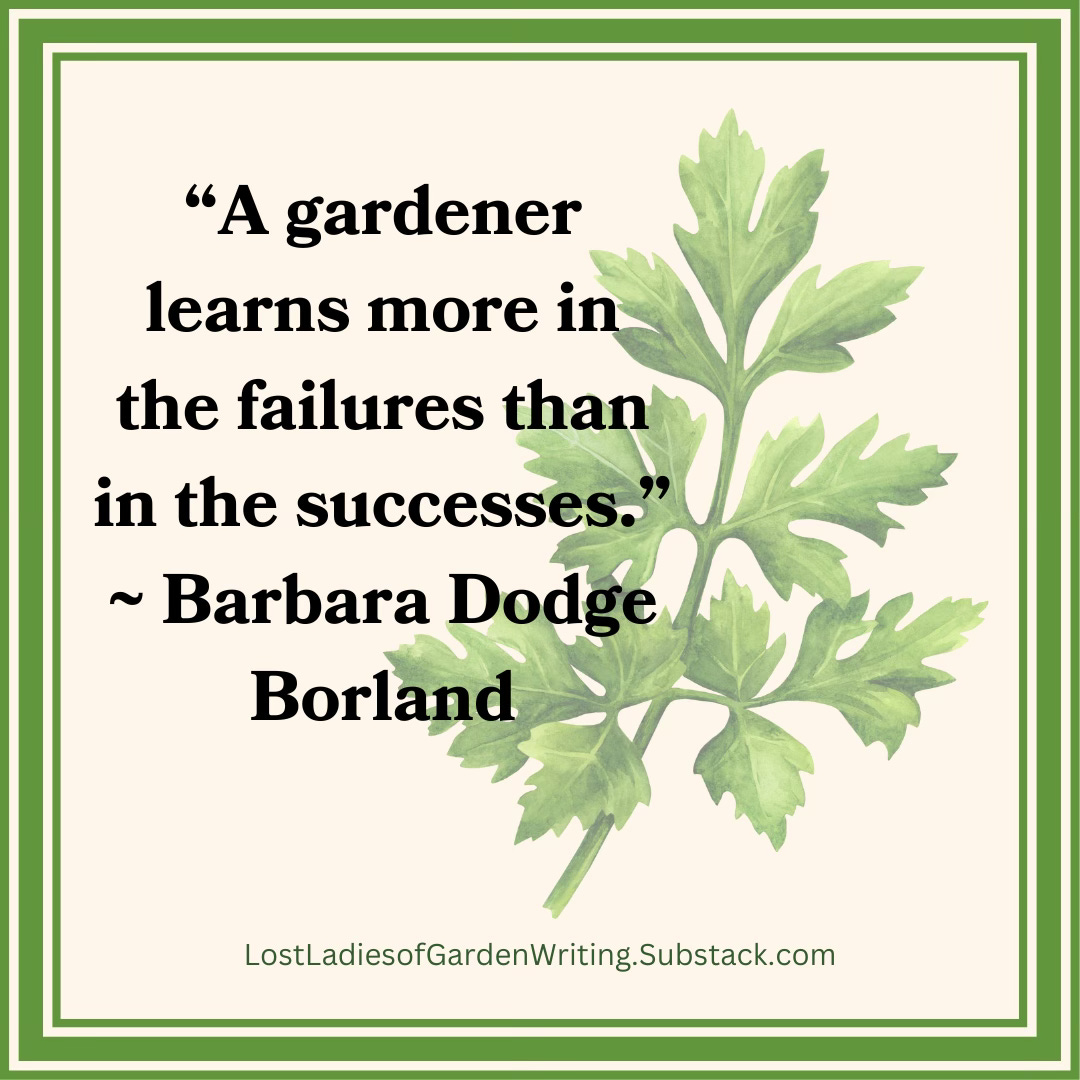I “met” Barbara Dodge Borland through her husband, the nature writer Hal Borland, who I found while searching for quotes for the gardening podcast, The Gardenangelists, that I record with Dee Nash. We kept finding great quotes by Hal Borland. Those quotes led me to read his book, This Hill, This Valley, in which he described Barbara’s tricks for growing lettuce.
I wrote a blog post about those lettuce-growing tricks and tips a few years ago, and actually tried them last year, even searching out the varieties of lettuce he said she grew.1
I didn’t think much more about Barbara Dodge Borland until this summer when I discovered that she didn’t just grow great lettuce for her husband to brag about and write about, she also wrote about it herself. She’s a Lost Lady of Garden Writing!
Her Biography
On the biography on the back leaf of her gardening book, This is the Way My Garden Grows, And Comes Into the Kitchen, it simply states:
“Barbara Dodge Borland, wife of the late Hal Borland, lives in Salisbury, Connecticut. Because of her somewhat unconventional methods of gardening, she has been called The Wayward Gardener, and once wrote a column under that name.”
I found more information about Barbara in her obituary published in The Berkshire Eagle (Pittsfield, Massachusetts).
Barbara was born in Waterbury, Connecticut on March 15, 1903 to Harry A. and Grace Cross Dodge. She attended St. Margaret’s School in Waterbury and went to Oberlin College in Ohio. During the 1930s she was a freelance editor and writing consultant in New York City where she also conducted fiction writing workshops.
She married Hal Borland in 1945. He was a widower at the time. In 1952, they moved to Salisbury, Connecticut where they lived on a 110-acre farm “on Weatogue Road beside the Housatonic River.” According to her obituary, for over three decades she was a co-author with her husband of novellas, short stories, and periodical articles.
She was survived by one stepson and a daughter, Diana. I determined through census records from 1950 that her daughter was born around 1935. My brief searches through Ancestry.com and Newspapers.com told me nothing about Barbara’s first husband and what might have happened to him, so I decided to file that under “none of my business.”
Barbara died in 1991 of an aneurysm. She was 87 years old. She asked that there be no funeral or memorial service.
Her Writing
Barbara’s husband Hal said she was “one of the best idea gals I’ve ever known, and also one of the best editors.” They worked as a team, according to an article in The Berkshire Eagle, Saturday, March 5, 1960.
I briefly looked for some of the “magazine novels published in Redbook” that they wrote together, but didn’t find any. I’m sure they are archived somewhere on the internet and might be found if someone did a lot of searching.
I also learned that beginning in 1960, Barbara started writing a weekly garden column for The Berkshire Eagle. On March 25, 1960, the editor of that newspaper wrote,
“Judging by her first column yesterday, ardent amateur gardener Barbara Borland writes with much of the same clarity that distinguishes husband Hal Borland’s Wednesday contributions to the feature page.”
High praise!
I couldn’t figure out when her columns ended though I did enjoy a few minutes of scrolling through old newspapers that didn’t feature just one column about gardening, but devoted at least two pages every week to several gardening related articles, columns and advertisements. Those were the days.
Her Books
Barbara wrote two books. The Great Hunger was published in 1962. It’s a novel about her Dodge ancestors in the Massachutsetts Bay Colony.
Then in 1986 at the age of 84, Barbara’s gardening book, This is the Way My Garden Grows, And Comes Into the Kitchen, was published. In her obituary, they described the book as “a book of original suggestions.” On the inside cover:
“This breezy, forthright book is for anyone who dreams of a thriving vegetable garden, but doesn’t want to be a slave to it. With the author’s short cuts and timesavers, three half-hours of care a week is all you need after planting; weeds can be where you want them (not where they want to be); and most of the bugs that attack plants can be eliminated. The methods here are completely different, often contrary to most gardening instructions. But they work—and they work anywhere, in any climate.”
Does the book deliver on those promises? Methods that are completey different but work in any climate? I’m still reading through it to decide if it does.
The book has four parts. In Part 1, Barbara described the various gardens she had, ending with her garden in Salisbury, Connecticut. In Part 2, she went through a list of vegetables and how she grew them. Yes, she was quite proud of her head lettuce especially.
In Part 3, “Special Gardens,” she wrote about gardens like “The Summer-Away Garden,” “The Six-Weeks Away Garden” and “The Easiest Garden.” She wrapped up the book with Part 4, “The Garden Comes into the Kitchen,” which were her recipes for cooking the vegetables she grew.
I’m pleased to have purchased a “good used” copy of this book so I know what she thinks is “The Easiest Garden.” It’s not a garden any gardener would want, or as she wrote, “In fact, I don’t want to see that garden.”
Quotable
Much of it this book is written in first person, so reading it is like sitting down with Barbara at her kitchen table while she patiently (hmmm… maybe impatiently?) explains all she learned about gardening by growing her own vegetables. And on that kitchen table is a feast she’s cooked from her own garden.
While sitting across from her, I can imagine her saying,
“I am a wayward, willful, contrary gardener. I don’t follow seed-packet directions. I find my methods of short cuts and timesavers so much easier.”
And she was adamant that her methods, which she learned by her own trial and error, worked because as she noted, “A gardener learns more in the failures than the successes.”
That’s just a sampling of Barbara’s “breezy, forthright” book on gardening. As I read more of it, I may be inclined to try more than just her lettuce growing tips in my own vegetable garden.
She’s a welcome addition to my growing list of Lost Ladies of Garden Writing.
Do you know of other women authors of gardening books that I should research as Lost Ladies of Garden Writing? Send them my way via a comment or email!
If you find these articles interesting and think others will too, please share them and/or subscribe.
I’ll return with the next Lost Lady of Garden Writing article in two weeks. In the meantime, you can find me in several places: my website and blog, The Gardenangelists podcast, and my weekly newsletter, In the Garden With Carol.
That blog post, “Growing Lettuce Like It’s 1957,” won a first-place award for personal blog writing from Woman’s Press Club of Indiana and an Honorable Mention from the National Federation of Press Women









What makes you think Barbara had a previous marriage? You said Hal was a widower; clearly he had a previous marriage and provided Barbara with a stepson. Maybe there are some details you left out, but based on what you wrote here there's no evidence she had a previous marriage.
Thank you for doing so much research and putting so much positive energy into this substack. I love it. I was a history major in college (go IU) and love connecting history to my passion gardening. The info is so fascinating, factual and interesting. Thanks so much. Basilbecky